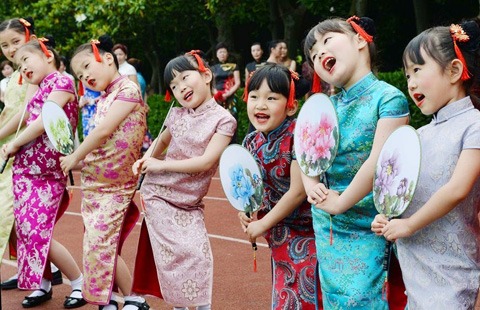In search of dream island
Updated: 2015-05-30 07:44
By Peng Yining In Dongshan, Fujian Province(China Daily)
|
||||||||
 |
|
Walking along the beach near Feng Dong Shi.[Photo provided to China Daily] |
It is a 200-ton rock, more than 4 meters in height, width and length, standing on a bigger rock with its tip. It used to be a part of the bigger rock, but had been gradually separated by water and weather. The locals say the rock will roll back and forth when the wind blows, but will never fall. It also shakes when people give it a shove, but touching the rock is strictly prohibited, to protect the unique site. The tumbler rock has been carved with poems and calligraphy, and is regarded as a spectacle and sacred place on the island.
In the 1980s, a television series, Journey to the West, based on one of the four greatest classical novels of Chinese literature, was filmed near the rock. There was a scene of the Monkey King being born from the stone. The popular series introduced Dongshan to a national audience and it became well known.
In 2014, Dongshan received more than 3 million tourists, 30 percent higher than the previous year, and its tourism revenue was 2.7 billion yuan ($435 million), 67 percent higher than the number in 2013.
But the island is not ready for visitors who want to spend a few pampered nights in a five-star resort, as it has only just begun to build luxury hotels which could be open to the public in two years' time. Most hotels now are small and old and the restaurants are really large stalls on the streets. But they will give you an experience of living in a small island which is home to 210,000 people.
A five-minute walk from the shaking rock is a temple of Guan Yu, a historical site in Dongshan. Chinese President Xi Jinping reportedly took a photo with his wife in front of the temple in the 1980s, when they visited the island. The president is said to have the picture in his office as a memento of his early political career in Fujian. Many visitors stand at the same spot where the president and first lady supposedly stood, to take pictures of themselves.
The Guan Yu Temple dates back to the Ming Dynasty (1368-1644). Guan Yu was a general in the Three Kingdoms period (AD 220-280). Seen as an epitome of loyalty and righteousness, Guan is still worshipped today by many Chinese people. Temples and shrines dedicated exclusively to Guan can be found on the Chinese mainland, Hong Kong, Macao, Taiwan, and other places with Chinese influence such as Vietnam and Japan.
- Half of college students want to work in second-tier cities: Survey
- CPC publishes 'self-decoding' books for Western audience
- Capital aiming for 208 new care centers for the elderly
- Ten photos you don’t wanna miss – May 29
- Guangdong police bust huge 'ice' labs
- Patients take precedence for top researcher
Most Viewed
Editor's Picks

|

|

|

|

|

|
Today's Top News
Chinese ambassador warns US against escalating situation in S China Sea
G7 backs inclusion of yuan in IMF basket of currencies
Magnitude 8.5 quake strikes off eastern Japan
China's most-wanted fugitive set to be extradited by US
US charges 15 Chinese nationals in college exam fraud scheme
Former US House Speaker Hastert indicted on federal charges
No one tells us what to do, Beijing says
Li: Spain a partner for new market
US Weekly

|

|














